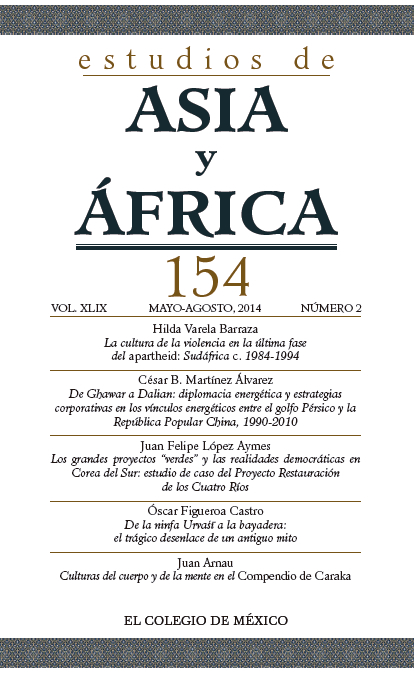Abstract
This paper discusses an important facet in the nineteenth-century European reception of the ancient tradition of India: the Romantic representation of the sacred dancer (devadāsī) through the figure of the bayadère in operas, ballets, dramas and other artistic expressions. In this context, the paper retrieves the devadāsī’s mythical and ritual dimensions, arguing that these provide key elements for a better understanding of the bayadère. To this end, the paper focuses on the famous nymph Urvaśī, the patron saint of dance and prostitution, and compares the Vedic cycle around this figure and Kālidāsa’s courtly version.References
Fuentes sánscritas
Amarasimha, Cosha, or, Dictionary of the Sanskrit language by Amera Sinha, ed. H. T. Colebrooke, Serampore, 1808.
Bharata, Nātyaśāstra with the commentary of Abhinavagupta, 4 vols., ed. M. Ramakrishna, Vadodara, Central Library, 1926-1965.
El Rig Veda, trad. J. M. de Mora, México, Conaculta, 1989, pp. 264-266.
Hymnes spéculatifs du Veda, trad. L. Renou, París, Gallimard, 1956.
Kālidāsa, Abhijñānaśākuntalam of Kālidāsa, ed. C. R. Devadhar, Delhi, Motilal Banarsidass, 1946.
Kālidāsa, How Úrvashi Was Won, trad. V. N. Rao y D. Shulman, Nueva York, New York University Press, 2009.
Kālidāsa, Kālidāsa’s Meghadūta, ed. E. Hultzsch, Londres, Royal Asiatic Society, 1911.
Kālidāsa, The Vikramorvaśīya of Kālidāsa, ed. H. D. Velankar, Delhi, Sahitya Akademi, 1961.
Rig Veda. A Metrically Restored Text, ed. B. A. van Noten y G. B. Holland, Cambridge, Harvard University Press, 1994.
Rig-Veda Sanskrit-Ausgabe mit Kommentar des Sayana (aus dem 14. Jh. n. Chr.) , 6 vols., ed. Max Müller, Londres, 1849-1875.
The Rig Veda, trad. W. Doniger, Delhi, Penguin Books, 1994, pp. 252-256.
The Śatapatha-Brāhmana, trad. J. Eggeling, Oxford, The Clarendon Press, 1900, vol. 44.
The Valmiki-Ramayana, 7 vols., ed. G. H. Bhatt y U. P. Shah, Vadodara, Oriental Institute, 1960-1975.
Yāska, The Nighantu and the Nirukta, the Oldest Indian Treatise on Etymology, Philology, and Semantics, ed. y trad. L. Sarup, Delhi, Motilal Banarsidass, 1967.
Estudios
Assayag, J., L’Inde fabuleuse : le charme discret de l’exotisme français, XVIIE-XXE siècles, París, Kimé, 1999.
Assayag, J., “Aurore et crépuscule de l’Ève indienne: l’imaginaire de la danseuse de temple entre théophile gautier et Pierre Loti”, en D. Lombard (ed.), Rêver l’Asie, París, Éditions de l’École des Hautes Études en sciences sociales, 1993, pp. 251-267.
Bor, J., “Mamia, Ammani and other Bayadères: Europa’s Portrayal of India’s Temple Dancers”, en M. Clayton y B. Zon (eds.), Music and Orientalism in the British Empire, 1780s-1940s, Aldershot, Ashgate, 2007, pp. 42-44.
Doniger, W., Śiva, The Erotic Ascetic, Oxford, Oxford University Press, 1973.
Figueira, D. M., The Exotic. A Decadent Quest, Albany, Suny Press, 1994.
Figueira, D. M., Translating the Orient. The Reception of Śākuntala in Nineteenth Century Europe, Albany, Suny Press, 1991.
Flaubert, G., Dictionnaire des idées reçues, París, Le Livre de Poche, 1997.
Gaur, R. C., “The Legend of Purūravas and Urvaśī: an Interpretation”, Journal of the Royal Asiatic Society of Great Britain and Ireland, vol. 106, núm. 2, 1974, pp. 142-152.
Geldner, K. F., “Die indische Balladendichtung”, Festschrift der Universität Marburg für die Philologenversammlung, Marburgo, 1913, pp. 33-40.
Goethe, J. W. von, “Der gott und die Bajadere”, en Goethes Werke, vol. 1, Munich, Droemersche Verlagsanstalt, 1953.
Goldman, R., “Mortal Man and Immortal Woman: an Interpretation of Three Ākhyāna Hymns of the Rgveda”, Journal of the Oriental Institute, vol. 18, núm. 4, 1969, pp. 273-303.
Gonda, J., “Ascetics and Courtesans”, Adyar Library Bulletin, vol. 25,1961, pp. 78-102.
Gonda, J., “Zur Frage nach dem Ursprung und Wesen des indischen Dramas”, Acta Orientalia, núm. 19, 1943, pp. 329-453.
Halbfass, W., India y Europa, México, Fondo de Cultura Económica, 2013.
Ingalls, D. D. H., “Kālidāsa and the Attitudes of the Golden Age”, Journal of the American Oriental Society, vol. 96, núm. 1, 1976, pp. 15-26.
Jones, William, The Works of Sir William Jones, ed. L. Teignmouth, Londres, John Stockdale, 1807, vol. 9, pp. 363-532.
Keith, A. B., “The Beginnings of the Indian Drama”, Journal of the Royal Asiatic Society of Great Britain and Ireland, vol. 48, núm. 1, 1916, pp. 146-151.
Kosambi, D. D., “Urvaśī and Purūravas”, en Myth and Reality. Studies in the Formation of Indian Culture, Bombay, Prakashan, 1962, cap. 2.
Leucci, T., Devadasi e bayadères: tra storia e leggenda, Bolonia, Clueb, 2005.
Lévi, S., Le Théâtre Indien, París, É. Bouillon, 1890, pp. 297-342.
Locke, R. P., Musical Exoticism. Images and Reflections, Cambridge, Cambridge University Press, 2009.
Marglin, F. A., Wives of the God-King, Delhi, Oxford University Press, 1985.
Mehta, B., Widows, Pariahs, and Bayadères: India as Spectacle, Londres, Bucknell University Press, 2002.
Namouchi, N., Käufliche Liebe. Prostitution im alten Indien, Berlín, Peter Lang, 1995.
Renou, L., “Les pouvoirs de la parole dans le Rgveda”, en Études védiques et pāninéennes, vol. 1, París, E. de Boccard, 1955, pp. 1-27.
Rubio, F. J., “Mito y ritual en la leyenda de Purūravas y Urvaśī (RV 10.95)”, Aula Orientalis, núm. 24, 2006, pp. 99-126.
Sani, S., “ Registri temporali e struttura narrativa: esegesi di RV X.95.5”, Studi e Saggi Linguistici, núm. 18, 1978, pp. 179-197.
Schuyler, M., “Bibliography of Kālidāsa’s Mālavikāgnimitra and Vikramorvaśī”, Journal of the American Oriental Society, núm. 23, 1902, pp. 93-101.
Underwood, D., “Le bayadère: la femme représentée et la femme représentante de l’Inde coloniale au XIXe siècle”, International Journal of Francophone Studies, vol. 5, núm. 2, julio, 2002, pp. 85-94.
Wurm, A., “The Ballad of Purūravas and Urvaśī (RV X.95)”, en V. N. Jha, New Horizons of Research in Indology, Pune, Centre Of Advanced Study in Sanskrit, 1989, pp. 39-47.
This work is licensed under a Creative Commons Attribution-NonCommercial-NoDerivatives 4.0 International License
Copyright 2022 Estudios de Asia y África


